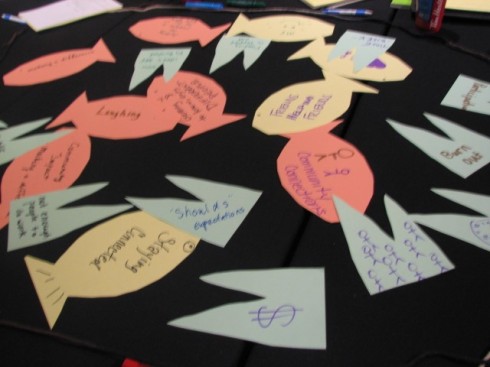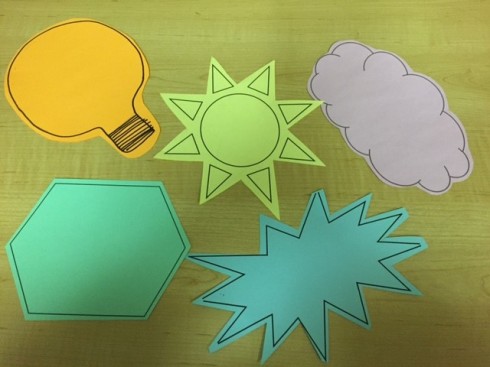I’m a big fan of using activities to draw out information in groups I work with. It seems much more effective that just asking questions of a big group. Lately I’ve been using “Fishes & Weeds” as one of my go-to facilitation techniques.
One of the interesting things about many facilitation techniques that I use is that I tend to “borrow” them from other facilitators. This means I’m not always aware of the history of the specific technique: where it came from, how it evolved, and how to attribute it. I borrowed “Fishes and Weeds” from my colleague Gillian Kranias, who tells me she developed it by adapting a common popular education technique of using cut-outs to focus collective dialogue, reflection and learning. You can find Gillian’s key questions for “Fishes and Weeds”, alongside a picture of its use (copied below), on page 4 of The Power of Reflection: an introduction to participator evaluation techniques.

Fishes & Weeds is a great activity that you can use to collect two sets of information (usually opposing) with a group. I frequently use it with groups or networks that have been working together for quite a while and are having issues with participation or attendance, some kind of communication difficulty, or simply want to refresh or revitalize their work. I’ve used the information gathered with this activity to draft mission/vision statements, to update terms of reference or to guide group processes. One of the (many) things I like about this activity is that it uses an asset-based approach: while you are trying to identify something challenging, limiting or difficult, you also identify things that are working well — strengths that the network can build on.
How the activity works
Design your questions: Determine what it is that you need to know, and then select two questions to gather the data that will give you that information. For example, if the group has had a drop-off in attendance or people are not fully participating in the group, you need to identify what the issues are that are keeping people from attending/participating. You might ask questions like:
- What do you VALUE about participating in the network? WHY do you participate in the network? WHAT keeps you coming back to this group? What do you LOVE about this work?
- What challenges are facing the network right now? What keeps you from participating/engaging in the network? What is preventing the group from moving forward?
Choose your shapes: Just because the activity is called “Fishes & Weeds” does not mean you have to use fish shapes and weed shapes. You can choose a shape that goes along with the mandate of your group, or your questions. For example:
- Lightbulbs (what is your one bright idea for moving the group forward?)
- Stop signs (what is stopping us from moving forward?)
- A “kapow” symbol (what one impact are we trying to achieve)
- A cloud (what is your dream for the network?)
Of course it’s not strictly necessary to use paper shapes and colours, but I do find that it’s a bit more fun than using sticky notes.

Step One: participants write on their shapes. Give participants a few minutes to write on their paper shapes (one idea/concept per shape). One of the benefits to this activity is that it gives everyone a chance to participate and share their ideas whether they are comfortable speaking up in a group or not.
Step Two: sharing shapes. There are a few options for how you can do this. You can simply collect the fishes and weeds and sort them, or you can have participants exchange shapes and read them out. I have two techniques to do this:
- Incorporate movement by putting on some music and have people dance around the room, handing out their fish/weed as they dance and collecting someone else’s in return. Stop the music at random times and ask participants to read the shapes they currently have to their partner. Repeat several times.
- If you are more limited on space or have a group that needs/wants to stay seated, have participants pass one shape (e.g. fish) two people to the right and the other shape (e.g. weed) two people to the left. Then each participant reads out the shapes that they have to the group. This is best in groups of under 15 participants as otherwise it can take a very long time.
The advantage to this is that participants get to hear the perspectives of others in the group, without having to read their own out loud.
Step Three: theming. Begin to sort the fishes and weeds into themes. Make sure the whole group hears the themes and have the group validate these themes (is there anything missing? Anything surprising? Etc.)

Step Four: using the data. Now is the fun part. With the themes, you’ve clearly identified what the group feels is important (positive/negative, benefits/challenges, strengths/weaknesses). You can now explore these themes with the group in conversation or using another facilitation technique.
For more ideas of facilitation techniques and participatory approaches, check out Facilitation for Healthy Communities Toolkit, The Power of Reflection: an introduction to participator evaluation techniques and Participatory Evaluation Toolkit.
Leave a comment